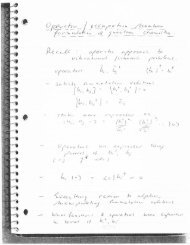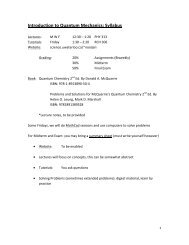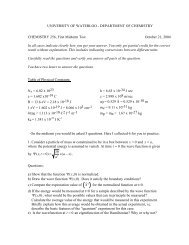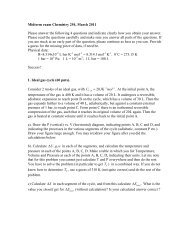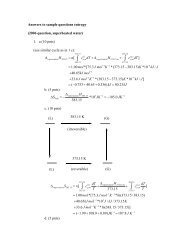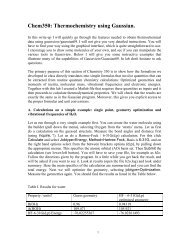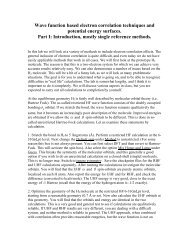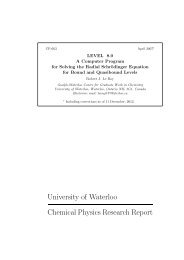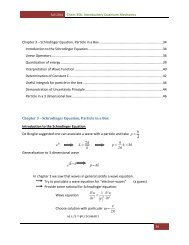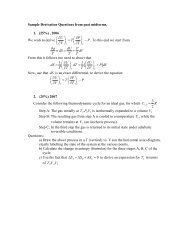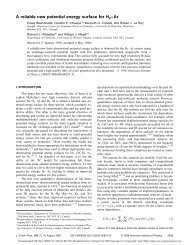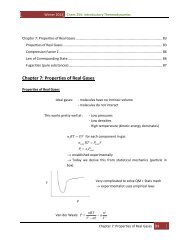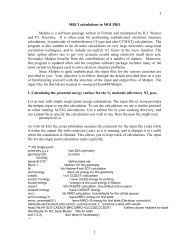Rapid, accurate calculation of the s-wave scattering length
Rapid, accurate calculation of the s-wave scattering length
Rapid, accurate calculation of the s-wave scattering length
You also want an ePaper? Increase the reach of your titles
YUMPU automatically turns print PDFs into web optimized ePapers that Google loves.
THE JOURNAL OF CHEMICAL PHYSICS 135, 154108 (2011)<br />
<strong>Rapid</strong>, <strong>accurate</strong> <strong>calculation</strong> <strong>of</strong> <strong>the</strong> s-<strong>wave</strong> <strong>scattering</strong> <strong>length</strong><br />
Vladimir V. Meshkov, 1 Andrey V. Stolyarov, 1,a) and Robert J. Le Roy 2,b)<br />
1 Department <strong>of</strong> Chemistry, Moscow State University, Moscow 119991, Russia<br />
2 Guelph-Waterloo Center for Graduate Work in Chemistry and Biochemistry, University <strong>of</strong> Waterloo,<br />
Waterloo, Ontario N2L 3G1, Canada<br />
(Received 24 June 2011; accepted 21 September 2011; published online 20 October 2011)<br />
Transformation <strong>of</strong> <strong>the</strong> conventional radial Schrödinger equation defined on <strong>the</strong> interval r ∈ [0, ∞)<br />
into an equivalent form defined on <strong>the</strong> finite domain y(r) ∈ [a, b] allows <strong>the</strong> s-<strong>wave</strong> <strong>scattering</strong> <strong>length</strong><br />
a s to be exactly expressed in terms <strong>of</strong> a logarithmic derivative <strong>of</strong> <strong>the</strong> transformed <strong>wave</strong> function φ(y)<br />
at <strong>the</strong> outer boundary point y = b, which corresponds to r =∞. In particular, for an arbitrary interaction<br />
potential that dies <strong>of</strong>f as fast as 1/r n for n ≥ 4, <strong>the</strong> modified <strong>wave</strong> function φ(y) obtained by<br />
using <strong>the</strong> two-parameter mapping function r(y; ¯r,β) = ¯r[1 + 1 tan(πy/2)] has no singularities, and<br />
β<br />
dφ(1)<br />
dy<br />
]. For a well bound potential with equilibrium distance r e, <strong>the</strong> optimal map-<br />
− 1. An outward integration procedure based on Johnson’s<br />
log-derivative algorithm [J. Comp. Phys. 13, 445 (1973)] combined with a Richardson extrapolation<br />
procedure is shown to readily yield high precision a s -values both for model Lennard-Jones<br />
(2n, n) potentials and for realistic published potentials for <strong>the</strong> Xe–e − , Cs 2 (a 3 u + ), and<br />
3, 4 He 2 (X 1 g + ) systems. Use <strong>of</strong> this same transformed Schrödinger equation was previously shown<br />
[V. V. Meshkov et al., Phys.Rev.A78, 052510 (2008)] to ensure <strong>the</strong> efficient <strong>calculation</strong> <strong>of</strong> all<br />
bound levels supported by a potential, including those lying extremely close to dissociation. © 2011<br />
American Institute <strong>of</strong> Physics. [doi:10.1063/1.3649946]<br />
a s = ¯r[1 + 2 1<br />
πβ φ(1)<br />
ping parameters are ¯r ≈ r e and β ≈ n 2<br />
I. INTRODUCTION<br />
The so-called <strong>the</strong> s-<strong>wave</strong> <strong>scattering</strong> <strong>length</strong> a s is a key parameter<br />
for describing <strong>the</strong> interaction <strong>of</strong> particles at very low<br />
collision energies. In particular, <strong>the</strong> two-body collision problem<br />
is completely specified by <strong>the</strong> <strong>scattering</strong> <strong>length</strong> in <strong>the</strong><br />
low temperature limit where <strong>the</strong> elastic cross section becomes<br />
σ e = 4πas 2.1, 2 Many <strong>of</strong> <strong>the</strong> properties <strong>of</strong> a Bose-Einstein condensate<br />
also depend only on <strong>the</strong> <strong>scattering</strong> <strong>length</strong>. 3 In particular,<br />
<strong>the</strong> chemical potential <strong>of</strong> a uniform Bose gas is simply<br />
proportional to <strong>the</strong> a s -value, 4 namely: μ Bose = a s n4π¯2/m,<br />
where n is <strong>the</strong> number density and m is <strong>the</strong> atomic mass. 5<br />
Thus, positive a s values correspond to overall repulsive interactions<br />
while negative values correspond to attractive ones.<br />
The <strong>scattering</strong> <strong>length</strong> is asymptotically related to <strong>the</strong> <strong>scattering</strong><br />
phase shift η s (k) by <strong>the</strong><br />
1, 2, 6<br />
expression,<br />
tan η s (k)<br />
a s =−lim , (1)<br />
k→0 k<br />
in which k is <strong>the</strong> relative <strong>wave</strong> vector <strong>of</strong> <strong>the</strong> colliding particles.<br />
The <strong>scattering</strong> <strong>length</strong> can be also determined from <strong>the</strong><br />
<strong>wave</strong>function ψ(r) <strong>of</strong> <strong>the</strong> radial Schrödinger equation solved<br />
at zero collision energy<br />
− d2 ψ(r)<br />
=− 2μ U(r) ≡ Q(r)ψ(r) (2)<br />
dr 2 ¯2 with <strong>the</strong> inner boundary condition ψ(0) = 0. It has been<br />
proved that for arbitrary potentials U(r) that obey <strong>the</strong> asympa)<br />
Electronic mail: avstol@phys.chem.msu.ru.<br />
b) Electronic mail: leroy@uwaterloo.ca.<br />
totic condition,<br />
lim<br />
r→∞ rn U(r) = 0 for n>3, (3)<br />
<strong>the</strong> <strong>wave</strong>function ψ(r) has <strong>the</strong> linear asymptotic form,<br />
ψ(r) ≃ S (r − a s ), r →∞, (4)<br />
in which <strong>the</strong> slope S is a constant. 1 It can be seen from<br />
Eq. (4) that <strong>the</strong> <strong>scattering</strong> <strong>length</strong> physically corresponds to<br />
<strong>the</strong> distance where <strong>the</strong> continuation <strong>of</strong> this asymptotic straight<br />
line crosses <strong>the</strong> r-axis. It is clear that <strong>the</strong> value <strong>of</strong> a s will<br />
be strongly depend on <strong>the</strong> interaction potential U(r) and on<br />
<strong>the</strong> reduced mass <strong>of</strong> <strong>the</strong> colliding particles μ. Itisalsowell<br />
known that <strong>the</strong> <strong>scattering</strong> <strong>length</strong> a s is approximately related<br />
to <strong>the</strong> binding energy Ev b max<br />
≥ 0 <strong>of</strong> <strong>the</strong> highest bound level<br />
(v = v max ) <strong>of</strong> <strong>the</strong> interaction potential U(r): 7<br />
√<br />
¯2<br />
a s ≈ . (5)<br />
2μEv b max<br />
It is clear that a s →+∞as Ev b max<br />
→ 0, while a s will take<br />
on large negative values if <strong>the</strong> potential well is almost deep<br />
enough to support one more bound level. In o<strong>the</strong>r words, depending<br />
on <strong>the</strong> potential and <strong>the</strong> reduced mass, <strong>the</strong> <strong>scattering</strong><br />
<strong>length</strong> can have any value on <strong>the</strong> interval ( −∞, +∞), where<br />
<strong>the</strong> limiting values <strong>of</strong> ±∞ are associated with cases in which<br />
<strong>the</strong> value <strong>of</strong> <strong>the</strong> slope S in Eq. (4) approaches zero.<br />
Scattering <strong>length</strong>s determined from studies <strong>of</strong> ultracold<br />
colliding atoms 8 complement conventional and photoassociation<br />
spectroscopy (PAS) spectroscopic data for <strong>the</strong> initial state<br />
in <strong>the</strong> PAS process, and <strong>of</strong>fer <strong>the</strong> possibility <strong>of</strong> constructing<br />
reliable global empirical interatomic potentials that are<br />
valid all <strong>the</strong> way to <strong>the</strong> dissociation limit. 9, 10 However, rapid<br />
0021-9606/2011/135(15)/154108/11/$30.00 135, 154108-1<br />
© 2011 American Institute <strong>of</strong> Physics<br />
Downloaded 11 Nov 2011 to 129.97.80.64. Redistribution subject to AIP license or copyright; see http://jcp.aip.org/about/rights_and_permissions
154108-2 Meshkov, Syolyarov, and Le Roy J. Chem. Phys. 135, 154108 (2011)<br />
and robust methods for performing <strong>scattering</strong> <strong>length</strong> <strong>calculation</strong>s<br />
are required to make such an inversion procedure feasible.<br />
Fur<strong>the</strong>rmore, a high degree <strong>of</strong> accuracy in <strong>the</strong> calculated<br />
a s -values is required in order to provide <strong>the</strong> <strong>accurate</strong> derivatives<br />
<strong>of</strong> <strong>the</strong> <strong>scattering</strong> <strong>length</strong> with respect to <strong>the</strong> parameters<br />
defining <strong>the</strong> potential that are required for performing such<br />
fits. 11 There are a number <strong>of</strong> existing schemes for calculating<br />
<strong>scattering</strong> <strong>length</strong>s. However, <strong>calculation</strong> <strong>of</strong> <strong>the</strong> <strong>scattering</strong><br />
phase shift η s (k) as a function <strong>of</strong> energy 1, 2 in order to apply<br />
<strong>the</strong> low-energy extrapolation <strong>of</strong> Eq. (1) leads to large uncertainties,<br />
especially for large a s values, since η s (k) becomes a<br />
very steep function in <strong>the</strong> vicinity <strong>of</strong> k = 0. Moreover, <strong>the</strong> direct<br />
numerical integration <strong>of</strong> <strong>the</strong> radial equation (2) cannot<br />
be performed easily because <strong>the</strong> asymptotic linear form <strong>of</strong><br />
Eq. (4) is only reached at very large distances r, typically<br />
thousands <strong>of</strong> Å. More robust methods are based on integration<br />
<strong>of</strong> Eq. (2) to some finite matching distance r m , and <strong>the</strong>n<br />
matching <strong>the</strong> resulting numerical <strong>wave</strong> function ψ(r m ) with<br />
an asymptotic counterpart for <strong>the</strong> long-range region which is<br />
known analytically for particular kinds <strong>of</strong> potentials. 11–13 Alternatively,<br />
<strong>the</strong> apparent a s -value obtained by truncating <strong>the</strong><br />
<strong>calculation</strong> at some finite distance r = r m can be corrected to<br />
take account <strong>of</strong> <strong>the</strong> missing long-range tail in <strong>the</strong> framework<br />
<strong>of</strong> a secular perturbation <strong>the</strong>ory expansion. 14 These asymptotic<br />
methods <strong>of</strong>ten yield fairly <strong>accurate</strong> results, but not for<br />
large a s values. Moreover, <strong>the</strong>y all require additional computational<br />
effort to ensure <strong>the</strong> convergence <strong>of</strong> results with<br />
respect to an optimal r m value whose position is not welldefined<br />
apriori. These asymptotic methods also cannot readily<br />
be used for potentials for which <strong>the</strong> asymptotic solution is<br />
not available in closed form. We also note that a very elegant<br />
analytical formula for a s has been obtained using <strong>the</strong> semiclassical<br />
approximation for <strong>the</strong> <strong>wave</strong>function ψ(r). 15 However,<br />
while that formula can be useful for estimation purposes,<br />
its accuracy is limited by its dependence on <strong>the</strong> WKB<br />
approximation, 1, 16 so it does not suffice for many applications.<br />
The key to <strong>the</strong> present method is <strong>the</strong> analytically exact<br />
transformation <strong>of</strong> <strong>the</strong> initial Schrödinger equation (2) defined<br />
on infinite domain r ∈ [0, ∞) into a modified radial equation<br />
defined by a reduced variable 19, 20 y(r) on a finite interval y(r)<br />
∈ [a, b]. 17, 18 The resulting transformed equation can be solved<br />
very efficiently by standard numerical methods, 21, 22 and an<br />
appropriate choice for <strong>the</strong> mapping function r(y) leads to a<br />
transformed <strong>wave</strong> function φ(b) that has no singularities on<br />
<strong>the</strong> interval [a, b]. In this case, <strong>the</strong> <strong>scattering</strong> <strong>length</strong> can be<br />
expressed analytically in terms <strong>of</strong> <strong>the</strong> logarithmic derivative<br />
<strong>of</strong> <strong>the</strong> solution at <strong>the</strong> (finite) end point b and <strong>the</strong> associated<br />
mapping parameters.<br />
One efficient way to obtain <strong>the</strong> required logarithmic<br />
derivatives <strong>of</strong> <strong>the</strong> <strong>wave</strong> function at y = b is to integrate numerically<br />
<strong>the</strong> resulting modified Ricatti equation using Johnson’s<br />
log-derivative method 23, 24 and apply a Richardson extrapolation<br />
to <strong>the</strong> values obtained at <strong>the</strong> limit. 25, 26 A FORTRAN code<br />
applying this approach that has been applied both to model<br />
Lennard-Jones (2n, n) potentials and to realistic potentials<br />
for Xe–e − , 27 for Cs 2 (a 3 + u ),12, 13, 15 and for 3, 4 He 2 (X 1 + g ),28<br />
taken from <strong>the</strong> literature, has been provided as supplementary<br />
material. 29 An alternate version <strong>of</strong> <strong>the</strong> present approach based<br />
on <strong>the</strong> conventional Numerov propagator 21 has been implemented<br />
in a “finite domain” version <strong>of</strong> <strong>the</strong> general purpose<br />
bound-state/Franck-Condon code LEVEL. 30<br />
II. ADAPTIVE MAPPING PROCEDURE FOR<br />
SCATTERING LENGTH CALCULATIONS<br />
A. Reduced variable transformation <strong>of</strong> <strong>the</strong> radial<br />
equation<br />
We begin by introducing a mapping function y = y(r) that<br />
is a smooth, monotonically increasing function <strong>of</strong> <strong>the</strong> radial<br />
coordinate r and maps [0, ∞) onto <strong>the</strong> finite domain [a, b].<br />
17, 18<br />
The substitution<br />
ψ(r(y)) = √ g(y)φ(y), g(y) ≡ dr > 0, (6)<br />
dy<br />
<strong>the</strong>n transforms <strong>the</strong> conventional radial Schrödinger<br />
equation (2) into <strong>the</strong> equivalent form,<br />
d 2 φ(y)<br />
=−˜Q(y)φ(y), (7)<br />
dy 2<br />
in which<br />
˜Q(y) ≡ g 2 (y)Q(r(y)) + F (y), (8)<br />
whose additive term is defined as<br />
F (y) ≡ g′′<br />
2g − 3 ( g<br />
′<br />
) 2<br />
. (9)<br />
4 g<br />
Note that a prime ( ′ ) symbol denotes differentiation with respect<br />
to <strong>the</strong> new radial variable y.<br />
It should be noted that<br />
1. <strong>the</strong> modified <strong>wave</strong> function φ(y) is now defined on <strong>the</strong><br />
finite domain [a, b];<br />
2. <strong>the</strong> modified radial equation (7) is completely equivalent<br />
to <strong>the</strong> initial one (2), as long as r(y) ∈ (C 3 [a,b]) is a<br />
monotonically increasing function;<br />
3. a knowledge <strong>of</strong> <strong>the</strong> inverse analytical function r(y) isall<br />
that is required to accomplish <strong>the</strong> exact transformations<br />
<strong>of</strong> Eqs. (6)–(9);<br />
4. for a fixed mesh <strong>of</strong> equally spaced points on <strong>the</strong> interval<br />
y ∈ [a, b], <strong>the</strong> function ρ(r) = dy/dr = 1/g(y) defines<br />
<strong>the</strong> density distribution <strong>of</strong> mesh points <strong>of</strong> <strong>the</strong> initial coordinate<br />
r.<br />
It is clear that conventional finite-difference 21, 23, 24, 26 and<br />
pseudospectral 22 methods can be used straightforwardly for<br />
integrating <strong>the</strong> transformed radial equation (7) out to <strong>the</strong> point<br />
y = b, as long as <strong>the</strong> modified <strong>wave</strong> function φ(y) is not singular<br />
anywhere on <strong>the</strong> interval [a, b], and especially not at its<br />
end points. Fur<strong>the</strong>rmore, it will be proved in Sec. II B that<br />
<strong>the</strong> <strong>scattering</strong> <strong>length</strong> a s is an explicit function <strong>of</strong> logarithmic<br />
derivative <strong>of</strong> <strong>the</strong> <strong>wave</strong> function φ(y),<br />
ξ(y) ≡ φ′ (y)<br />
φ(y) , (10)<br />
at <strong>the</strong> boundary y = b. It is well known that <strong>the</strong> transformation<br />
(10) converts <strong>the</strong> radial equation (7) into <strong>the</strong> modified Ricatti<br />
Downloaded 11 Nov 2011 to 129.97.80.64. Redistribution subject to AIP license or copyright; see http://jcp.aip.org/about/rights_and_permissions
154108-3 Calculation <strong>of</strong> <strong>the</strong> s-<strong>wave</strong> <strong>scattering</strong> <strong>length</strong> J. Chem. Phys. 135, 154108 (2011)<br />
equation<br />
ξ ′ (y) + ˜Q(y) + ξ 2 (y) = 0, (11)<br />
which can be numerically integrated, for instance, using Johnson’s<br />
efficient log-derivative method. 23, 24 More details regarding<br />
this method are given in <strong>the</strong> Appendix.<br />
B. Developing a formula for <strong>the</strong> <strong>scattering</strong> <strong>length</strong><br />
Since Eq. (4) shows that <strong>the</strong> <strong>scattering</strong> <strong>length</strong> can be expressed<br />
formally in terms <strong>of</strong> <strong>the</strong> asymptotic behavior <strong>of</strong> <strong>the</strong><br />
ordinary radial <strong>wave</strong>function ψ(r), we can write<br />
a s ≃ r −<br />
ψ(r) , r →∞. (12)<br />
dψ(r)/dr<br />
It, <strong>the</strong>refore, seems desirable to investigate <strong>the</strong> asymptotic behavior<br />
<strong>of</strong> <strong>the</strong> modified function φ(y) near <strong>the</strong> outer boundary<br />
point y = b corresponding to r →∞, where<br />
φ(y) ≃ S r(y) − a s<br />
√ dr(y)/dy<br />
, y → b. (13)<br />
Since we are mapping an infinite interval onto a finite<br />
one, it is clear that <strong>the</strong> mapping function r(y) musthavea<br />
singularity at <strong>the</strong> upper end <strong>of</strong> <strong>the</strong> interval. To proceed, we<br />
assume that this singularity has <strong>the</strong> form<br />
1<br />
r(y) ∼ , y → b, (14)<br />
(b − y)<br />
γ<br />
where necessarily γ>0, because <strong>the</strong> r(y) function must go<br />
to infinity as y approaches b in order to convert <strong>the</strong> finite domain<br />
y ∈ [a, b] into <strong>the</strong> infinite one r ∈ [r min , +∞]. Inserting<br />
Eq. (14) into Eq. (13) yields<br />
φ(y) ≃ S(b − y) 1−γ<br />
2 , y → b (15)<br />
and differentiating that result with respect to y yields<br />
φ ′ 1 − γ<br />
(y) ≃ S , y → b. (16)<br />
(b − y) 1+γ<br />
2<br />
From Eqs. (15) and (16) it is immediately clear that for both<br />
<strong>the</strong> modified <strong>wave</strong> function φ(y) and its derivative φ ′ (y) to<br />
be non-singular at <strong>the</strong> point y = b (or r =+∞), necessarily<br />
γ = 1.<br />
Avoidance <strong>of</strong> this singularity at y = b is clearly desirable<br />
if we are to integrate <strong>the</strong> modified radial equation (7)<br />
<strong>accurate</strong>ly on <strong>the</strong> whole interval [a, b], so it is necessary to<br />
choose a mapping function r(y) that has only a simple pole at<br />
<strong>the</strong> end point y = b. It is <strong>the</strong>refore convenient to express r(y)<br />
as a Laurent series expansion about this point,<br />
r(y) =<br />
c −1<br />
b − y + c 0 +<br />
∞∑<br />
c i (b − y) i , (17)<br />
where c −1 > 0. Inserting Eq. (17) into Eq. (13) and differentiating<br />
<strong>the</strong> resulting expression for φ(y) with respect to y yields,<br />
at <strong>the</strong> point y = b,<br />
φ(b) = S √ c −1 , φ ′ (b) = S(a s − c 0 )<br />
√ , (18)<br />
c−1<br />
i=1<br />
which shows that<br />
a s = c −1 ξ(b) + c 0 (19)<br />
is <strong>the</strong> desired relationship between <strong>the</strong> <strong>scattering</strong> <strong>length</strong> a s<br />
and <strong>the</strong> log-derivative function at <strong>the</strong> outer end <strong>of</strong> <strong>the</strong> interval,<br />
ξ(b).<br />
To facilitate <strong>accurate</strong> <strong>calculation</strong> <strong>of</strong> <strong>the</strong> required value <strong>of</strong><br />
ξ(b), it is desirable that <strong>the</strong> function ˜Q(y) <strong>of</strong>Eq.(8) be nonsingular<br />
at <strong>the</strong> end point y = b. It is easy to verify that <strong>the</strong> F(y)<br />
contribution is nonsingular at y = b, since<br />
F (b) =− 3c 1<br />
. (20)<br />
c −1<br />
Moreover, from Eq. (17) it is clear that in <strong>the</strong> limit y → b (or<br />
r →∞),<br />
g(y) ≡ dr(y)<br />
dy<br />
≃<br />
c −1<br />
(b − y) 2 ∝ r2 . (21)<br />
This means that for any potential which dies <strong>of</strong>f more slowly<br />
than 1/r 4 , <strong>the</strong> product g 2 U(r) that comprises <strong>the</strong> main part <strong>of</strong><br />
<strong>the</strong> function ˜Q(y) (seeEq.(8)) diverges in <strong>the</strong> limit y → b<br />
(r →+∞). In particular, if U(r →∞) ≃−C n /r n , <strong>the</strong>n as<br />
y → b ,<br />
g 2 U(y) ≃ 2μ C n (b − y) n−4<br />
, (22)<br />
¯2<br />
(c −1 ) n−2<br />
and hence<br />
⎧<br />
F (b) n>4,<br />
⎪⎨<br />
2μ C n<br />
˜Q(b) =<br />
+ F (b) n = 4,<br />
¯2<br />
(c −1 )<br />
2<br />
⎪⎩<br />
∞ n
154108-4 Meshkov, Syolyarov, and Le Roy J. Chem. Phys. 135, 154108 (2011)<br />
Ogilvie-Tipping (OT) potential energy expansion variable, 19<br />
y OT (r; ¯r) = r − ¯r<br />
r + ¯r ; y OT ∈ [−1, 1]. (24)<br />
For this case Eq. (19) shows that <strong>the</strong> <strong>scattering</strong> <strong>length</strong> is explicitly<br />
defined as<br />
a s = ¯r [2 ξ(1) − 1] , (25)<br />
while <strong>the</strong> reciprocal mapping function is<br />
( ) 1 + y<br />
r OT (y) = ¯r<br />
(26)<br />
1 − y<br />
and<br />
2¯r (r + ¯r)2<br />
g OT (y) = = . (27)<br />
(1 − y)<br />
2<br />
2¯r<br />
Moreover, for this mapping function <strong>the</strong> additive term<br />
F OT (y) = 0.<br />
Use <strong>of</strong> <strong>the</strong> simple one-parameter mapping function <strong>of</strong><br />
Eq. (24) does provide a reliable method for calculating a s .<br />
However, our recent experience with applying this type <strong>of</strong><br />
transformation to bound-state problems 18 suggests that better<br />
efficiency may be attained using more flexible two-parameter<br />
functions. One such function which was successfully used<br />
for bound-state <strong>calculation</strong>s is <strong>the</strong> two-parameters (¯r, α>0)<br />
Šurkus variable, 20<br />
y S (r; ¯r,α) = rα − ¯r α<br />
r α + ¯r ; y α S ∈ [−1, 1], (28)<br />
for which <strong>the</strong> reciprocal mapping function is<br />
( ) 1 + y 1/α<br />
r S (y) = ¯r<br />
. (29)<br />
1 − y<br />
However, except for <strong>the</strong> special case α = 1 for which<br />
y S (r; ¯r,α) reduces to y OT (r; ¯r), this mapping function is not<br />
appropriate for <strong>scattering</strong>-<strong>length</strong> <strong>calculation</strong>s, since when α<br />
≠ 1 <strong>the</strong> mapping function r S (y) does not take on <strong>the</strong> required<br />
Laurent series expansion form (17) as y → 1, so <strong>the</strong> associated<br />
log-derivative <strong>wave</strong>function ξ(y) becomes singular <strong>the</strong>re.<br />
In contrast, <strong>the</strong> two-parameters tangential function 22<br />
[<br />
r tg (y) = ¯r 1 + 1 ( πy<br />
) ]<br />
β tan (30)<br />
2<br />
defined on <strong>the</strong> interval y ∈ [(2/π)tan −1 ( − β), 1], whose inverse<br />
is <strong>the</strong> inverse tangent function,<br />
y tg (r; ¯r,β) = 2 π tan−1 [β (r/¯r − 1)], (31)<br />
completely conforms to <strong>the</strong> required Laurent expansion form<br />
<strong>of</strong> Eq. (17) as y → 1, since<br />
r tg (y) ≃<br />
2¯r<br />
πβ(1 − y)<br />
π ¯r<br />
+ ¯r − (1 − y) + ... . (32)<br />
6β<br />
For this case<br />
[ ] 2ξ(1)<br />
a s = ¯r<br />
πβ + 1 , (33)<br />
and it is easy to show that <strong>the</strong> additive contribution to Eq. (8)<br />
is a constant,<br />
F tg (y) = π 2<br />
4 , (34) and that<br />
g tg (y) = π ¯r<br />
2β cos−2 (πy/2), (35)<br />
= π ¯r<br />
2β [1 + β2 (r/¯r − 1) 2 ].<br />
D. Determination <strong>of</strong> optimal mapping parameters<br />
The optimal values <strong>of</strong> <strong>the</strong> parameters defining <strong>the</strong> mapping<br />
function <strong>of</strong> Eq. (30) may be expected to depend both<br />
on <strong>the</strong> nature <strong>of</strong> <strong>the</strong> interaction potential U(r) and on <strong>the</strong> particular<br />
numerical method used for integration <strong>of</strong> <strong>the</strong> modified<br />
radial equation (7). When using Johnson’s log-derivative<br />
method <strong>of</strong> integration, 23, 24 <strong>the</strong> optimal mapping parameters ¯r<br />
and β could be determined by minimizing <strong>the</strong> truncation error<br />
ξ estimated using a Richardson extrapolation (RE, see<br />
Eq. (A7)), or by minimizing <strong>the</strong> difference between ξ h1 (y<br />
= b) and ξ h2 (y = b) values corresponding to two different integration<br />
step sizes h 1 and h 2 ,<br />
min |ξ h1 − ξ h2 |. (36)<br />
Note that it is tacitly assumed that <strong>the</strong> optimal parameter values<br />
do not depend on <strong>the</strong> integration step size. This has been<br />
confirmed by <strong>the</strong> illustrative <strong>calculation</strong>s presented in Sec. III.<br />
It will also be shown <strong>the</strong>re that <strong>the</strong> minimum <strong>of</strong> <strong>the</strong> functional<br />
(36) is a ra<strong>the</strong>r smooth function <strong>of</strong> both mapping parameters,<br />
¯r and β.<br />
It seems reasonable to assume that <strong>the</strong> optimal mapping<br />
function would correspond to <strong>the</strong> situation in which<br />
˜Q(y) ≡ g 2 (y)Q(r(y)) + F (y) ≈ constant, (37)<br />
since it is well-known that minimal truncation errors arise in<br />
particle-in-a-box problems where <strong>the</strong> potential U(r) does not<br />
depend on r. Fur<strong>the</strong>rmore, within <strong>the</strong> classically allowed region<br />
where Q ≫ 0, <strong>the</strong> additive term F(y) can be approximately<br />
neglected. 1, 16 In this case Eq. (37) reduces to g 2 Q<br />
≈ const, and inverting this condition (recalling that g(y)<br />
≡ dr/dy) yields<br />
√<br />
y opt (r>r 0 ) ∼ Q(r)dr. (38)<br />
r 0<br />
Here r 0 is <strong>the</strong> left-hand (inner) classical turning point, which<br />
is <strong>the</strong> root <strong>of</strong> <strong>the</strong> equation U(r 0 ) = 0.<br />
Differentiating Eq. (38) with respect to r yields<br />
ρ opt ≡ dy opt<br />
∼ √ √<br />
Q(r) ≡ − 2μ U(r). (39)<br />
dr<br />
¯2 For optimal mapping, <strong>the</strong>refore, <strong>the</strong> density function ρ opt (r)<br />
should be close to √ Q(r) in<strong>the</strong>Q(r) ≫ 0 region where <strong>the</strong><br />
original <strong>wave</strong>function ψ(r) has its maximum oscillation frequency.<br />
From Eq. (39) it follows that choice <strong>of</strong> <strong>the</strong> optimal<br />
mapping does not depend on <strong>the</strong> reduced mass μ, because it<br />
appear in Q(r) simply as a multiplicative factor. It is also easy<br />
to see that <strong>the</strong> mapping function (38) transforms <strong>the</strong> modified<br />
<strong>wave</strong>function φ(y) into <strong>the</strong> familiar particle-in-a-box form<br />
∫ r<br />
φ opt (y) ∼ A sin(ky) + B cos(ky), (40)<br />
Downloaded 11 Nov 2011 to 129.97.80.64. Redistribution subject to AIP license or copyright; see http://jcp.aip.org/about/rights_and_permissions
154108-5 Calculation <strong>of</strong> <strong>the</strong> s-<strong>wave</strong> <strong>scattering</strong> <strong>length</strong> J. Chem. Phys. 135, 154108 (2011)<br />
Wave function [arb.u.]<br />
1<br />
0.5<br />
0<br />
ψ(r)<br />
S (r − a s )<br />
−0.5<br />
0 50 a s 100 150 200<br />
1.5<br />
1.0<br />
0.5<br />
0.0<br />
Internuclear distance, r [au]<br />
a s =¯r 1+ 2<br />
πβ<br />
1 dφ(1)<br />
φ(1) dy<br />
φ(1)<br />
Density function, ρ(r)<br />
1.5<br />
1.0<br />
0.5<br />
0.0<br />
ρ OT (r)<br />
ρ tg (r)<br />
ρ WKB (r)<br />
−0.5<br />
−1.0<br />
−1.5<br />
φ(y)<br />
−0.2 0.0 0.2 0.4 0.6 0.8 1.0<br />
Reduced variable, y tg<br />
ψ(r)<br />
−0.5<br />
5 10 15 20 25 30 35 40<br />
Internuclear distance, r [au]<br />
FIG. 1. Comparison <strong>of</strong> <strong>the</strong> original ψ(r) and modified φ(y) = ψ/ √ g tg<br />
unbound <strong>wave</strong> functions at zero energy for <strong>the</strong> a 3 u<br />
+ state <strong>of</strong> Cs 2 (see<br />
Ref. 15), as calculated using <strong>the</strong> Numerov method (see Refs. 21, 29). The<br />
scaling function g tg (r) was calculated from Eq. (35) using mapping parameters<br />
¯r = r e = 12.0 [a.u.] and β = 2.<br />
which correlates with <strong>the</strong> conventional WKB approximation<br />
1, 16<br />
in <strong>the</strong> classically allowed region where Q(r) > 0.<br />
As is shown by Fig. 1, in contrast to <strong>the</strong> original <strong>wave</strong>function<br />
ψ(r), <strong>the</strong> modified <strong>wave</strong>function φ(y) has loops <strong>of</strong> almost<br />
constant amplitude and spacing over <strong>the</strong> potential well,<br />
behavior which is qualitatively very similar to that implied by<br />
Eq. (40). It is <strong>the</strong>refore expected that <strong>the</strong> WKB mapping <strong>of</strong><br />
Eq. (38) should be close to “optimal” for all numerical methods<br />
(such as <strong>the</strong> finite-difference and collocation methods)<br />
that are based on an equidistant grid in <strong>the</strong> classical region<br />
<strong>of</strong> motion. It should be stressed, however, that <strong>the</strong> mapping<br />
function defined by Eq. (38) cannot itself be applied for <strong>scattering</strong><br />
<strong>length</strong> <strong>calculation</strong>s, because it does not satisfy <strong>the</strong> required<br />
asymptotic behavior <strong>of</strong> Eq. (17), and because it becomes<br />
imaginary in <strong>the</strong> classically forbidden region where<br />
r < r 0 .<br />
It is easy seen from Eqs. (27) and (35) that <strong>the</strong> density<br />
function ρ OT (r) corresponding to <strong>the</strong> one-parameter mapping<br />
function <strong>of</strong> Eq. (24) is proportional to 1/[r + ¯r] 2 , while that<br />
for <strong>the</strong> two-parameters tangent function <strong>of</strong> Eq. (31) has a<br />
Lorentzian form with a maximum at ¯r. The plots presented<br />
in Fig. 2, show that <strong>the</strong>re is good agreement between <strong>the</strong><br />
ρ WKB (r) and ρ tg (r) density functions over much <strong>of</strong> <strong>the</strong> domain<br />
<strong>of</strong> <strong>the</strong> <strong>wave</strong>function ψ(r). This leads to <strong>the</strong> conclusion that <strong>the</strong><br />
optimal value <strong>of</strong> parameter ¯r opt should be close to <strong>the</strong> equilibrium<br />
internuclear distance r e <strong>of</strong> <strong>the</strong> potential U(r). Hence,<br />
for <strong>the</strong> two-parameters mapping function (31), it seems reasonably<br />
to fix ¯r opt ≈ r e and to vary only <strong>the</strong> single parameter<br />
β. Note that <strong>the</strong> pronounced differences among <strong>the</strong> density<br />
functions for <strong>the</strong>se three cases at small distances is not very<br />
FIG. 2. Mapping density functions ρ(r) = dy/dr = 1/g(r)for<strong>the</strong>a 3 + u state<br />
<strong>of</strong> Cs 2 (see Ref. 15) calculated: (i) within <strong>the</strong> framework <strong>of</strong> <strong>the</strong> conventional<br />
WKB approximation ρ WKB = √ −U(r) (39), (ii) using <strong>the</strong> one-parameter<br />
y OT (r; ¯r) mapping function (24) with ¯r = r e = 12.0 [a.u.], and (iii) using <strong>the</strong><br />
two-parameters y tg (r; ¯r,β) mapping function (31) with ¯r = r e and β = 2.<br />
ψ(r) is <strong>the</strong> associated zero-energy <strong>wave</strong>function.<br />
important, because <strong>the</strong> associated <strong>wave</strong> function ψ(r)dies<strong>of</strong>f<br />
exponentially in this region.<br />
In <strong>the</strong> following, <strong>the</strong>refore, parameter ¯r <strong>of</strong> <strong>the</strong> mapping<br />
functions y OT (r; ¯r) <strong>of</strong>Eq.(24) and y tg (r; ¯r,β)<strong>of</strong>Eq.(31) is<br />
fixed as ¯r = r e , while <strong>the</strong> optimum value <strong>of</strong> β <strong>of</strong> Eq. (31) is<br />
determined from a one-dimensional minimization <strong>of</strong> <strong>the</strong> functional<br />
<strong>of</strong> Eq. (36).<br />
III. IMPLEMENTATION, TESTING, AND DISCUSSION<br />
A. Model-potential applications and tests<br />
A computer program based on <strong>the</strong> adaptive mapping procedure<br />
described above has been written and tested, 29 both for<br />
a variety <strong>of</strong> model potentials, and on potentials for real systems<br />
taken from <strong>the</strong> literature. All results were obtained on<br />
32 bit processors, mainly using double-precision arithmetic,<br />
but with quadruple-precision <strong>calculation</strong>s being used sometimes<br />
in order to delineate <strong>the</strong> impact <strong>of</strong> accumulated numerical<br />
round-<strong>of</strong>f error. This section presents <strong>the</strong> results <strong>of</strong> those<br />
illustrative applications, toge<strong>the</strong>r with some general discussion<br />
<strong>of</strong> <strong>the</strong> method.<br />
The first sample <strong>calculation</strong>s presented here are for <strong>the</strong><br />
model Lennard-Jones(2n, n) potentials,<br />
[ (re ) 2n ( re<br />
) ] n<br />
U LJ (r) = D e − 2 , (41)<br />
r r<br />
defined by <strong>the</strong> potential function parameters and system reduced<br />
mass listed in Table I. The first three <strong>of</strong> <strong>the</strong>se LJ(2n,<br />
n) potentials, each supporting 15 bound vibrational levels, are<br />
Downloaded 11 Nov 2011 to 129.97.80.64. Redistribution subject to AIP license or copyright; see http://jcp.aip.org/about/rights_and_permissions
154108-6 Meshkov, Syolyarov, and Le Roy J. Chem. Phys. 135, 154108 (2011)<br />
TABLE I. The s-<strong>wave</strong> <strong>scattering</strong> <strong>wave</strong><strong>length</strong>s a s (in Å) calculated for<br />
<strong>the</strong> LJ(2n, n) potentials defined by Eq. (41) (Ref. 29). All models have<br />
equilibrium distance r e = 1 [Å] and <strong>the</strong> reduced mass is set as μ<br />
= 16.85762920 [a.u.] so that in “spectroscopists units,” <strong>the</strong> scaling factor<br />
¯2/2μ<br />
= 1[cm −1 Å 2 ]. D e is <strong>the</strong> well depth in cm −1 , while v max is <strong>the</strong> vibrational<br />
quantum number <strong>of</strong> <strong>the</strong> last bound level supported by <strong>the</strong> potential.<br />
n v max D e β opt<br />
n<br />
2 − 1 a s a a s<br />
4 14 1000 0.9 1.0 277.4 310.54293138289<br />
5 14 2165 1.5 1.5 234.9 246.72686552846<br />
6 14 3761 2.1 2.0 236.1 242.48308194261<br />
6 99 176200 2.1 2.0 10.849479064634<br />
6 99 174370 2.1 2.0 11552.057690297<br />
a The a s estimates obtained using <strong>the</strong> last-level binding energy approximation <strong>of</strong> Eq. (5).<br />
<strong>the</strong> same models systems considered in our recent application<br />
<strong>of</strong> this adaptive mapping approach to bound-state problems. 18<br />
The last two LJ(12, 6) potentials have much deeper wells and<br />
support 100 vibrational levels. They were introduced here to<br />
highlight <strong>the</strong> efficiency <strong>of</strong> <strong>the</strong> present method, since <strong>the</strong> computational<br />
effort <strong>of</strong> <strong>scattering</strong>-<strong>length</strong> <strong>calculation</strong>s increases<br />
dramatically as v max and <strong>the</strong> absolute magnitude <strong>of</strong> a s -values<br />
increase.<br />
Converged a s -values for five model LJ(2n, n) potentials<br />
are presented in <strong>the</strong> last column <strong>of</strong> Table I. As discussed<br />
above, <strong>the</strong> range-mapping parameter was fixed at ¯r = r e = 1<br />
[Å] for both y OT (r) and y tg (r) mapping functions. The optimal<br />
β opt values for <strong>the</strong> latter case were determined by minimizing<br />
<strong>the</strong> functional <strong>of</strong> Eq. (36), yielding <strong>the</strong> results shown in <strong>the</strong><br />
column four. It is interesting to see that <strong>the</strong>se empirically determined<br />
β opt values have essentially <strong>the</strong> same dependence on<br />
<strong>the</strong> inverse-power n governing <strong>the</strong> long-range behavior <strong>of</strong> <strong>the</strong><br />
potential as was <strong>the</strong> case for <strong>the</strong> analogous parameter α <strong>of</strong> <strong>the</strong><br />
Šurkus-variable mapping (28) used in <strong>the</strong> bound-state study<br />
<strong>of</strong> Ref. 18.<br />
The log-log plots in Figs. 3 and 4 show how <strong>the</strong> relative<br />
errors in <strong>the</strong> calculated a s values<br />
δ =<br />
∣<br />
a calc<br />
s<br />
a exact s<br />
− 1<br />
∣ (42)<br />
depend on <strong>the</strong> number <strong>of</strong> mesh points N used in <strong>the</strong> radial<br />
integration. The reference values as<br />
exact were obtained from<br />
<strong>calculation</strong>s using quadruple precision arithmetic by increasing<br />
N until <strong>the</strong> full desired level <strong>of</strong> convergence was achieved.<br />
The numerical “noise” on <strong>the</strong>se plots for δ 10 −12 indicates<br />
<strong>the</strong> precision limits achieved using ordinary double-precision<br />
arithmetic, while <strong>the</strong> dashed lines show how <strong>the</strong> convergence<br />
trend continues when quadruple-precision arithmetic is used.<br />
The three upper curves in Fig. 3 (labeled JLD) display results<br />
obtained using Johnson’s log-derivative method (JLD),<br />
while <strong>the</strong> three lower curves illustrate <strong>the</strong> greatly improved<br />
convergence achieved when that approach is coupled to <strong>the</strong><br />
(N, N/2) Richardson extrapolation procedure described in <strong>the</strong><br />
Appendix. These results clearly confirm <strong>the</strong> prediction <strong>of</strong><br />
Eq. (A5), that JLD, and that method combined with a Richardson<br />
extrapolation to zero step (JLD-RE), demonstrate N −4 and<br />
N −6 convergence rates, respectively. We see that for <strong>the</strong>se 15-<br />
level LJ potentials, <strong>the</strong> JLD-RE(N, N/2) method allows us to<br />
Relative error, δ<br />
10 −1 LJ(12, 6)<br />
10 −3<br />
LJ(10, 5) JLD<br />
δ ∼ 1/N 4<br />
10 −5<br />
LJ(8, 4)<br />
10 −7<br />
10 −9<br />
JLD-RE<br />
δ ∼ 1/N 6<br />
10 −11<br />
10 −13<br />
10 −15<br />
LJ(8, 4)<br />
LJ(10, 5)<br />
LJ(12, 6)<br />
10 2 10 3 10 4 10 5<br />
Number <strong>of</strong> <strong>the</strong> grid points, N<br />
FIG. 3. Convergence tests for a s -values calculated in double precision arithmetic<br />
for <strong>the</strong> model 15-level LJ(2n, n) potentials <strong>of</strong> Table I using <strong>the</strong> oneparameter<br />
mapping function y OT (r; ¯r) (24) with ¯r = r e = 1 [Å]. Calculations<br />
performed using Johnson’s log-derivative method alone are denoted “JLD,”<br />
while <strong>the</strong> results labeled “JLD-RE” were obtained by also applying a (N,N/2)-<br />
Richardson extrapolation procedure to those results.<br />
Relative error, δ<br />
10 −1<br />
10 −3<br />
10 −5<br />
10 −7<br />
10 −9<br />
LJ(8, 4)<br />
10 −11 15 levels<br />
a s ≈ 311<br />
10 −13<br />
LJ(10, 5)<br />
15 levels<br />
a s ≈ 247<br />
10 −15<br />
LJ(12, 6)<br />
15 levels<br />
a s ≈ 242<br />
10 −17<br />
LJ(12, 6)<br />
100 levels<br />
a s ≈ 11552<br />
LJ(12, 6)<br />
100 levels<br />
a s ≈ 11<br />
10 2 10 3 10 4 10 5 10 6<br />
Number <strong>of</strong> <strong>the</strong> grid points, N<br />
FIG. 4. Convergence tests for a s -values calculated by <strong>the</strong> JLD-RE(N,N/2)<br />
method in normal double-precision arithmetic (solid curves) for <strong>the</strong> five<br />
model LJ(2n, n) potentials <strong>of</strong> Table I using <strong>the</strong> two-parameters y tg (r; ¯r<br />
= r e ,β) mapping function <strong>of</strong> Eq. (31) with <strong>the</strong> optimal parameters β opt listed<br />
<strong>the</strong>re. The dashed lines present results obtained by using quadruple-precision<br />
arithmetic.<br />
Downloaded 11 Nov 2011 to 129.97.80.64. Redistribution subject to AIP license or copyright; see http://jcp.aip.org/about/rights_and_permissions
154108-7 Calculation <strong>of</strong> <strong>the</strong> s-<strong>wave</strong> <strong>scattering</strong> <strong>length</strong> J. Chem. Phys. 135, 154108 (2011)<br />
10 −1 β opt ≈ 2.1<br />
2.5<br />
Relative error, δ<br />
10 −2<br />
10 −3<br />
10 −4<br />
10 −5<br />
10 −6<br />
N = 1000<br />
N = 2000<br />
N = 4000<br />
N = 8000<br />
Optimal parameter, βopt<br />
2.0<br />
1.5<br />
1.0<br />
LJ(6, 12)<br />
LJ(5, 10)<br />
LJ(4, 8)<br />
β opt ≈ 2.1<br />
β opt ≈ 1.5<br />
β opt ≈ 0.9<br />
10 −7<br />
10 −8<br />
N = 15000<br />
0.5<br />
0 3000 6000 9000 12000 15000<br />
2μ<br />
2 D e<br />
10 −9<br />
0.0 1.0 2.0 3.0 4.0 5.0 6.0 7.0 8.0<br />
Mapping parameter, β<br />
FIG. 5. Relative errors (42) in a s -values obtained for <strong>the</strong> 15-level LJ(12, 6)<br />
potential (41) as functions <strong>of</strong> <strong>the</strong> mapping parameter β, whereN is <strong>the</strong> number<br />
<strong>of</strong> grid points used in <strong>the</strong> JLD method.<br />
attain 11–12 significant digits in calculated a s values when<br />
using only N ≈ 10 4 radial mesh points.<br />
The results displayed in Fig. 4 show that as expected,<br />
<strong>the</strong> computational effort increases significantly for <strong>the</strong> 100-<br />
level LJ(2n, n) models, especially for <strong>the</strong> very last case considered<br />
in Table I, for which <strong>the</strong> <strong>scattering</strong> <strong>length</strong> is extremely<br />
large: a s ≈ 10 4 [Å]. However, even for those cases full doubleprecision<br />
converge is achieved with only N ≈ 10 5 . Note that<br />
for a given number <strong>of</strong> grid points, use <strong>of</strong> <strong>the</strong> simple oneparameter<br />
mapping function y OT (r) yields relative errors that<br />
are only ∼10 times larger than <strong>the</strong> analogous results yielded<br />
by <strong>the</strong> optimum two-parameter functions y tg (r). The nonlinear<br />
“cusp”-like behavior near N ≈ 10 3 on <strong>the</strong> JLD-RE plots<br />
in Figs. 3 and 4 appears to be due to accidental cancellation <strong>of</strong><br />
higher-order terms in <strong>the</strong> RE series expansion for <strong>the</strong>se cases.<br />
It does not appear in analogous results based on use <strong>of</strong> a Numerov<br />
propagator.<br />
The results presented in Fig. 5 clearly show that <strong>the</strong> accuracies<br />
<strong>of</strong> a s values calculated with any given number <strong>of</strong> mesh<br />
points N vary smoothly with <strong>the</strong> value <strong>of</strong> mapping parameter<br />
parameter β. They also show that <strong>the</strong> optimal parameter value<br />
β opt is essentially independent <strong>of</strong> <strong>the</strong> number <strong>of</strong> integration<br />
points used. Analogous results are obtained when modeling<br />
LJ(2n, n) potentials with n = 4 and 5.<br />
The sensitivity <strong>of</strong> <strong>the</strong> value <strong>of</strong> β opt to <strong>the</strong> depth <strong>of</strong> <strong>the</strong> potential<br />
energy well has also been investigated. Figure 6 shows<br />
that <strong>the</strong> values <strong>of</strong> β opt for model LJ(2n, n) potentials only<br />
depend significantly on <strong>the</strong> dissociation energy D e for very<br />
shallow potentials which support only a few bound states. For<br />
such species (e.g., see <strong>the</strong> He 2 example considered below),<br />
<strong>accurate</strong> <strong>scattering</strong> <strong>length</strong>s can readily be calculated using a<br />
relatively small number <strong>of</strong> grid points, so determining pre-<br />
FIG. 6. Optimal mapping parameter β opt as a function <strong>of</strong> <strong>the</strong> dissociation<br />
energy D e <strong>of</strong> 15-level LJ(2n, n) potentials (41) for n = 4, 5, and 6.<br />
cise values <strong>of</strong> β opt is immaterial. Overall, Fig. 6 shows that<br />
<strong>the</strong> optimal value <strong>of</strong> <strong>the</strong> β parameter in <strong>the</strong> mapping function<br />
<strong>of</strong> Eq. (31) depends mainly on <strong>the</strong> inverse-power n governing<br />
<strong>the</strong> limiting long-range behavior <strong>of</strong> <strong>the</strong> interaction potential.<br />
As indicated by Fig. 6 and Table I, <strong>the</strong>se optimal values are<br />
approximately defined by <strong>the</strong> simple relationship<br />
β opt ≈ n − 1, (43)<br />
2<br />
at least for <strong>the</strong>se LJ(2n, n)-like potentials. We believe that this<br />
empirical rule will be valid when applying <strong>the</strong> two-parameter<br />
mapping function <strong>of</strong> Eq. (30) to any deeply bound interatomic<br />
potential having a long-range tail which dies <strong>of</strong>f as 1/r n for<br />
n ≥ 4.<br />
It is interesting to note that <strong>the</strong> two-parameters mapping<br />
function y tg (r; ¯r,β)<strong>of</strong>Eq.(31) is also well suited for solving<br />
<strong>the</strong> Schrödinger equation for <strong>the</strong> bound-state problem discussed<br />
in Ref. 18. In particular, Fig. 7 shows how <strong>the</strong> values<br />
<strong>of</strong> β opt evolve if this mapping parameter is optimized independently<br />
for each level <strong>of</strong> our three 15-level LJ(2n, n) potentials.<br />
Except for <strong>the</strong> very last level, <strong>the</strong> values <strong>of</strong> β opt smoothly<br />
approach <strong>the</strong> limiting value implied by Eq. (43) as <strong>the</strong> vibrational<br />
levels approach dissociation. The substantial deviation<br />
from this limiting behavior for <strong>the</strong> lower vibrational levels<br />
is not a matter <strong>of</strong> concern, since those levels can readily be<br />
located <strong>accurate</strong>ly using a very wide range <strong>of</strong> β values, and<br />
since <strong>the</strong>ir radial amplitude is much smaller than that for <strong>the</strong><br />
highest levels, <strong>the</strong> overall computational efficiency for such<br />
levels is not very strongly dependent on <strong>the</strong> value <strong>of</strong> β. The<br />
abrupt drop-<strong>of</strong>f in <strong>the</strong> values <strong>of</strong> β opt for <strong>the</strong> very last level<br />
also mimics <strong>the</strong> behavior found in Ref. 18 using very different<br />
mapping functions (29) based on <strong>the</strong> Šurkus variable defined<br />
by Eq. (28). 20 This abrupt decrease <strong>of</strong> β opt for <strong>the</strong> last<br />
very weakly bound vibrational level v = v max = 14 is related<br />
to <strong>the</strong> form <strong>of</strong> <strong>the</strong> corresponding <strong>wave</strong>function ψ vmax (r) which<br />
has a very broad last loop centered at a very large internuclear<br />
distance. In particular, for <strong>the</strong> case <strong>of</strong> a last level which lies<br />
Downloaded 11 Nov 2011 to 129.97.80.64. Redistribution subject to AIP license or copyright; see http://jcp.aip.org/about/rights_and_permissions
154108-8 Meshkov, Syolyarov, and Le Roy J. Chem. Phys. 135, 154108 (2011)<br />
Optimal parameter, βopt<br />
10.0<br />
9.0<br />
8.0<br />
7.0<br />
6.0<br />
5.0<br />
4.0<br />
3.0<br />
2.0<br />
1.0<br />
LJ(6, 12)<br />
LJ(5, 10)<br />
LJ(4, 8)<br />
0.0<br />
0 2 4 6 8 10 12 14<br />
Vibrational quantum number, v<br />
FIG. 7. Optimal mapping parameters β opt determined for <strong>the</strong> bound vibrational<br />
levels v ∈ [0, 14] <strong>of</strong> <strong>the</strong> model 15-level LJ(2n, n) potentials (41) for<br />
n = 4, 5, and 6. The dashed horizontal lines correspond to <strong>the</strong> β opt values<br />
implied by Eq. (43).<br />
extremely close to dissociation, it appears that a small limiting<br />
value <strong>of</strong> β opt 0.5 is needed to provide a sufficiently<br />
broad distribution <strong>of</strong> grid points to characterize properly <strong>the</strong><br />
outermost loop <strong>of</strong> <strong>the</strong> <strong>wave</strong>function.<br />
B. Applications to “real” systems<br />
This section describes application <strong>of</strong> our new method <strong>of</strong><br />
performing <strong>scattering</strong> <strong>length</strong> <strong>calculation</strong>s to three “real” physical<br />
problems. The first <strong>of</strong> <strong>the</strong>se is <strong>the</strong> elastic <strong>scattering</strong> <strong>of</strong> a<br />
free electron from a neutral Xe atom. The function used for<br />
<strong>the</strong> Xe–e − interaction potential is <strong>the</strong> “Hartree-Fock dispersion”<br />
(HFD)-type potential reported by Szmytkowski 13 (with<br />
energy and distance in atomic units),<br />
U Xe−e −(r) = Ae −γr2 − ∑<br />
F n (r) C n /r n , (44)<br />
n=4,6<br />
in which A = 306.0 and γ = 1.0, while <strong>the</strong> n-dependent damping<br />
function F n has <strong>the</strong> form<br />
F n (r) = [1 − e −(r/r c) 2 ] n (45)<br />
with r c = 1.89 being a cut-<strong>of</strong>f radius, such that F n (r)<br />
= 0 for r < r c . Following Czuchaj et al., 27 its dispersion<br />
coefficients C 4 = α 1 /2 and C 6 = (α 2 − 6β 1 )/2 in<br />
Eq. (44) correspond to <strong>the</strong> familiar charge/induced-dipole and<br />
charge/induced-quadrupole interactions, where α 1 = 27.292<br />
and α 2 = 128.255 are <strong>the</strong> static dipole and quadrupole polarizabilities<br />
<strong>of</strong> <strong>the</strong> Xe atom, while β 1 = 29.2 is <strong>the</strong> dynamical<br />
correction to <strong>the</strong> dipole polarizability. This shallow U Xe−e −(r)<br />
interaction potential supports no bound levels and its scatter-<br />
TABLE II. Comparison <strong>of</strong> s-<strong>wave</strong> <strong>scattering</strong> <strong>length</strong>s a s (in a.u.) obtained<br />
by applying <strong>the</strong> JLD-RE(N,N/2) procedure (Ref. 29) to realistic published<br />
potentials for Xe–e − (Ref. 27), Cs 2 (a 3 u + )(Refs.12, 13 and 15), and<br />
3, 4 He 2 (X 1 g + ) (Ref. 28) interactions, using <strong>the</strong> two-parameter mapping<br />
function y tg (r; ¯r,β)<strong>of</strong>Eq.(31). The optimal mapping parameters β opt were<br />
determined by minimization <strong>the</strong> functional (36), while <strong>the</strong> ¯r values (in a.u.)<br />
were fixed at <strong>the</strong> equilibrium distance <strong>of</strong> <strong>the</strong> relevant potential, ¯r = ¯r opt<br />
= r e .<br />
Species Potential n v max a s β opt ¯r opt<br />
Xe–e − Eq. (44) 4 a −4.95280521509712 1.7 3.2<br />
−4.95281 b<br />
Cs 2 Eq. (46) 6 57 68.215967213 2.0 12.0<br />
68.21596 c<br />
68.21823 a<br />
68.0 d<br />
4 He 2 Eq. (48) 6 0 236.3688418603 2.5 5.67<br />
236.36884174 e<br />
3 He 2<br />
a −13.17845206095 3.6 5.67<br />
−13.178452062 d<br />
a There are no bound levels.<br />
b Reference 13.<br />
c Reference 12.<br />
d Reference 15.<br />
e Reference 11.<br />
ing <strong>length</strong> is negative, as was determined by Szmytkowski<br />
using an asymptotic method. 13<br />
The present a s -value for this system (in a.u.), given in <strong>the</strong><br />
first row <strong>of</strong> Table II, was converged to 14 significant digits using<br />
<strong>the</strong> JLD-RE(N,N/2) method based on N ≈ 10 3 grid points<br />
and a scaling factor <strong>of</strong> ¯2/2μ = 0.5. However, only N ≈ 100<br />
grid points are required to converge <strong>the</strong> present a s -value to 7<br />
significant digits. The present estimate agrees with <strong>the</strong> value<br />
reported by Szmytkowski 13 to within <strong>the</strong> 6 significant digit<br />
that he reports (see row 2 <strong>of</strong> Table II).<br />
Our second real-world example is a modified HFDtype<br />
potential for <strong>the</strong> a 3 u<br />
+ ground triplet state <strong>of</strong> <strong>the</strong> cesium<br />
dimer (again, with energies and distances in atomic<br />
12, 13, 15<br />
units),<br />
∑<br />
U Cs2 (r) = Ar α e −γr − F (r) C n /r n . (46)<br />
n=6,8,10<br />
The first term in Eq. (46), defined by constants A = 8 × 10 −4 ,<br />
α = 5.53, and γ = 1.072, represents <strong>the</strong> exchange repulsion<br />
energy, while <strong>the</strong> second is a sum <strong>of</strong> van der Waals dispersion<br />
terms (with coefficients C 6 = 7.02 × 10 3 , C 8 = 1.1 × 10 6 ,<br />
C 10 = 1.7 × 10 8 ) multiplied by <strong>the</strong> n-independent damping<br />
function<br />
F (r) = H (r − r c ) + H (r c − r) e −(r c/r−1) 2 , (47)<br />
where H(x) is <strong>the</strong> Heaviside step function: H(x) = 1(0), when<br />
x ≥ (
154108-9 Calculation <strong>of</strong> <strong>the</strong> s-<strong>wave</strong> <strong>scattering</strong> <strong>length</strong> J. Chem. Phys. 135, 154108 (2011)<br />
significant digits, respectively. The present method required<br />
about N ≈ 10 4 grid points to obtain 10 significant digits in <strong>the</strong><br />
calculated a s -value.<br />
Our third practical application is to <strong>the</strong> ground X 1 g<br />
+<br />
state <strong>of</strong> <strong>the</strong> helium dimer, for which <strong>the</strong> interaction potential<br />
is again represented by a HFD-type function written as (with<br />
energies in K and distances in Å) 28<br />
[<br />
)]<br />
U He2 (r) = D A exp(−γx) − F (x) C n /x n , (48)<br />
( ∑<br />
n<br />
in which x = r/r m , D = 10.8, A = 544 850.4, γ = 13.353384,<br />
C 6 = 1.3732412, C 8 = 0.4253785, C 10 = 0.1781, and r m<br />
= 2.9673. The damping function F(x) inEq.(48) is defined<br />
by Eq. (47) with <strong>the</strong> parameter x c = r c /r m = 1.28. This is<br />
an exotic example <strong>of</strong> very shallow interatomic potential, as<br />
it supports only a single bound level for <strong>the</strong> heavier isotopologue<br />
4 He 2 and no bound levels at all for <strong>the</strong> lighter isotopologue<br />
3 He 2 . For consistency with <strong>the</strong> <strong>calculation</strong>s <strong>of</strong> Ref. 11,<br />
<strong>the</strong> values <strong>of</strong> <strong>the</strong> scaling factors ¯2/2μ used in <strong>the</strong> present <strong>calculation</strong><br />
were 16.085775 and 12.120904 for 3 He 2 and 4 He 2 ,<br />
respectively.<br />
The results presented in <strong>the</strong> last four rows <strong>of</strong> Table II<br />
show that <strong>the</strong> present a s -values (first entry for each case)<br />
agree with <strong>the</strong> result obtained in Ref. 11 using <strong>the</strong> asymptotic<br />
method to about 10 significant digits. However, <strong>the</strong> JLD-<br />
RE(N, N/2) procedure used here required only N = 100 grid<br />
points to obtain a s -values for both isotopologues with uncertainties<br />
<strong>of</strong> only 0.01%.<br />
An interesting general point concerns <strong>the</strong> fact that <strong>the</strong><br />
convergence behavior <strong>of</strong> <strong>the</strong> a s values calculated for Cs 2 and<br />
He 2 at high N was not as smooth as it was for <strong>the</strong> model<br />
LJ(2n, n) and realistic Xe–e − potentials; this is demonstrated<br />
by <strong>the</strong> contrast between <strong>the</strong> curves in Fig. 4 and <strong>the</strong> “non-<br />
Relative error, δ<br />
10 −7 smooth<br />
JLD<br />
10 −9<br />
10 −11<br />
10 −13<br />
non-smooth<br />
JLD<br />
smooth<br />
JLD-RE<br />
non-smooth<br />
JLD-RE<br />
0 500 1000 1500 2000<br />
Number <strong>of</strong> <strong>the</strong> grid points, N<br />
FIG. 8. Comparison <strong>of</strong> convergence behavior for <strong>scattering</strong> <strong>length</strong>s implied<br />
by <strong>the</strong> 3 He 2 (X 1 g + ) potential (see Ref. 28) as calculated by <strong>the</strong> JLD(N) and<br />
JLD-RE(N, N/2) procedures using smooth vs. non-smooth long-range damping<br />
functions <strong>of</strong> Eq. (47).<br />
Relative error, δ<br />
10 −3 1<br />
10 −6<br />
10 −9<br />
10 −12<br />
Xe–e −<br />
10 −15<br />
0.5 1.0 1.5 2.0 2.5<br />
10 −3 1<br />
10 −6<br />
10 −9<br />
10 −12<br />
10 −3 1<br />
10 −6<br />
10 −9<br />
4 He 2<br />
3 He 2<br />
2.0 2.5 3.0 3.5 4.0 4.5<br />
Cs 2<br />
10 −12<br />
9.0 9.2 9.4 9.6 9.8<br />
Internuclear distance, r min [au]<br />
FIG. 9. Convergence <strong>of</strong> calculated <strong>scattering</strong> <strong>length</strong>s for <strong>the</strong> Xe–e − ,<br />
3, 4 He 2 (X 1 g + ), and Cs 2(a 3 u + ) systems with respect to <strong>the</strong> lower bound<br />
<strong>of</strong> <strong>the</strong> integration interval, r min ,wherer 0 is <strong>the</strong> distance where U(r) = 0.<br />
smooth” curves in Fig. 8. We attribute this behavior to <strong>the</strong><br />
discontinuous second and higher derivatives <strong>of</strong> <strong>the</strong> damping<br />
function F(x) in <strong>the</strong> potentials <strong>of</strong> Eqs. (46) and (48), at<strong>the</strong><br />
point r = r c . To confirm this assertion, <strong>the</strong> a s <strong>calculation</strong>s for<br />
3 He 2 were repeated with <strong>the</strong> Heaviside switching function <strong>of</strong><br />
Eq. (47) replaced by <strong>the</strong> smooth switching function<br />
H ˜<br />
1<br />
(x) = . (49)<br />
1 + e−20x The results obtained in this way, plotted as <strong>the</strong> “smooth”<br />
curves in Fig. 8, clearly confirm our assertion. This demonstrates<br />
<strong>the</strong> importance <strong>of</strong> having potential energy functions<br />
models which have a very high degree <strong>of</strong> analytic<br />
smoothness.<br />
Our final point concerns <strong>the</strong> sensitivity <strong>of</strong> <strong>the</strong> calculated<br />
a s values to <strong>the</strong> position <strong>of</strong> <strong>the</strong> inner boundary r min (y<br />
= a) <strong>of</strong> <strong>the</strong> integration region. While <strong>the</strong> transformation <strong>of</strong><br />
Eqs. (30) and (31) formally fixes <strong>the</strong> lower bound for y tg (r)<br />
to correspond to r = 0, <strong>the</strong> exponentially rapid decay <strong>of</strong> <strong>the</strong><br />
<strong>wave</strong>function in <strong>the</strong> classically forbidden region under <strong>the</strong><br />
short-range repulsive potential wall means that in practice that<br />
lower bound may be set quite a bit closer to <strong>the</strong> left turning<br />
point r 0 where U(r) = 0. To examine this point, Fig. 9<br />
shows <strong>the</strong> convergence behavior <strong>of</strong> calculated values <strong>of</strong> a s for<br />
<strong>the</strong> three real systems <strong>of</strong> Table II as <strong>the</strong> lower limit <strong>of</strong> <strong>the</strong><br />
integration interval is shifted inward from <strong>the</strong> distance r 0 .It<br />
was found that values <strong>of</strong> r min for which <strong>the</strong> relative error approaches<br />
<strong>the</strong> double-precision numerical-noise limit can be<br />
r 0<br />
r 0<br />
r 0<br />
Downloaded 11 Nov 2011 to 129.97.80.64. Redistribution subject to AIP license or copyright; see http://jcp.aip.org/about/rights_and_permissions
154108-10 Meshkov, Syolyarov, and Le Roy J. Chem. Phys. 135, 154108 (2011)<br />
defined by <strong>the</strong> criterion,<br />
(r min − r 0 ) ×<br />
√<br />
2μ<br />
¯2 |U(r min)| 23, (50)<br />
which is based on semi-classical exponential decay <strong>of</strong> <strong>the</strong><br />
original ψ(r) <strong>wave</strong>function in <strong>the</strong> classically forbidden region<br />
by a factor <strong>of</strong> ∼10 −10 .For<strong>the</strong>y tg (r; ¯r,β) mapping function<br />
<strong>of</strong> Eq. (31), this implies an inner (left hand) boundary point<br />
<strong>of</strong> a = 2 π tan−1 [β(r min /¯r − 1)] .<br />
IV. CONCLUSIONS<br />
This paper presents a very robust and efficient new way<br />
<strong>of</strong> calculating <strong>scattering</strong> <strong>length</strong>s. The two-parameter mapping<br />
function <strong>of</strong> Eq. (30) transforms <strong>the</strong> conventional radial<br />
Schrödinger equation (2) into <strong>the</strong> equivalent form <strong>of</strong> Eq. (7)<br />
defined on <strong>the</strong> finite domain y ∈ [a, 1]. For arbitrary interaction<br />
potentials, nei<strong>the</strong>r <strong>the</strong> solution φ(y) <strong>of</strong> <strong>the</strong> transformed<br />
equation nor its first derivative φ ′ (y) are singular anywhere on<br />
this interval. As a result, <strong>the</strong> s-<strong>wave</strong> <strong>scattering</strong> <strong>length</strong> a s can<br />
be exactly expressed in terms <strong>of</strong> <strong>the</strong> logarithmic derivative <strong>of</strong><br />
this transformed <strong>wave</strong> function φ(y = 1) at <strong>the</strong> right boundary<br />
point, as specified by Eq. (33). The method does not depend<br />
on a particular asymptotic form <strong>of</strong> <strong>the</strong> potential, as long as it<br />
dies <strong>of</strong>f as fast as 1/r n for n ≥ 4, as r →∞. The simplicity,<br />
robustness, and efficiency <strong>of</strong> this approach will greatly facilitate<br />
<strong>the</strong> use <strong>of</strong> fits to <strong>scattering</strong> <strong>length</strong>s in <strong>the</strong> modeling <strong>of</strong> cold<br />
atom collision phenomena.<br />
For strongly bound potentials with equilibrium distance<br />
r e and a limiting (attractive) long-range behavior <strong>of</strong> 1/r n ,<strong>the</strong><br />
optimal values <strong>of</strong> <strong>the</strong> y tg (r) mapping parameters have been<br />
shown to be ¯r ≈ r e and β ≈ n − 1, respectively. These same<br />
2<br />
mapping parameters also yield efficient solutions when this<br />
approach is used for solving bound-state problems. Regardless<br />
<strong>of</strong> <strong>the</strong> absolute magnitude <strong>of</strong> <strong>the</strong> <strong>scattering</strong> <strong>length</strong> or <strong>the</strong><br />
number <strong>of</strong> bound levels supported by <strong>the</strong> potential, <strong>the</strong> accuracy<br />
<strong>of</strong> <strong>the</strong> a s <strong>calculation</strong> can easily achieve 10–12 significant<br />
digits when working in ordinary double-precision arithmetic.<br />
It is also shown that stable and highly precise values <strong>of</strong> a s cannot<br />
be determined for analytical potentials which lack highorder<br />
analytic smoothness throughout <strong>the</strong> classically allowed<br />
region. A computer program applying this approach has been<br />
submitted to <strong>the</strong> Journal’s online data archive. 29 We also note<br />
that although it requires a little more computational effort to<br />
achieve a given level <strong>of</strong> precision, combination <strong>of</strong> <strong>the</strong> y OT (r)<br />
mapping function <strong>of</strong> Eq. (24) with a conventional Numerov<br />
<strong>wave</strong>function propagator 21 can yield both <strong>accurate</strong> a s values<br />
and <strong>wave</strong>functions φ(y) that can be used for calculating photoassociation<br />
cross sections and o<strong>the</strong>r properties. 30<br />
Finally, we note that <strong>the</strong> present method <strong>of</strong> solving a<br />
transformed Schrödinger equation has already been applied to<br />
solving <strong>the</strong> multi-channel bound-state problem. 31, 32 It should<br />
<strong>the</strong>refore be a straightforward matter to combing <strong>the</strong> multichannel<br />
version <strong>of</strong> <strong>the</strong> log-derivative propagator with <strong>the</strong><br />
present mapping procedure, since our final formula for <strong>the</strong><br />
<strong>scattering</strong> <strong>length</strong> will remain valid in <strong>the</strong> asymptotic region<br />
where <strong>the</strong> channels become decoupled.<br />
ACKNOWLEDGMENTS<br />
This work has been supported by <strong>the</strong> Russian Foundation<br />
for Basic Research by grant 10-03-00195a, and by Natural<br />
Sciences and Engineering Research Council (NSERC)<br />
Canada. The Moscow team is also grateful for partial support<br />
from <strong>the</strong> Federal Program “Scientists and Educators for an<br />
Innovative Russia 2009-2013” (Contract No. P 2280).<br />
APPENDIX: JOHNSON’S LOG-DERIVATIVE METHOD<br />
As was shown in Refs. 23 and 24, Johnson’s quadrature<br />
procedure for outward integration <strong>of</strong> <strong>the</strong> Riccati equation (11)<br />
is based on <strong>the</strong> two-point finite-difference scheme,<br />
z k =<br />
z (<br />
k−1 h<br />
2<br />
)<br />
− w k u k , (A1)<br />
1 + z k−1 3<br />
where ξ k (y k ) = h −1 z k (y k ), <strong>the</strong> mesh points are y k = a + kh,<br />
<strong>the</strong> integration step is h = (b − a)/N, and<br />
⎧<br />
⎪⎨<br />
˜Q(y k ) k = 0, 2, 4, ... ,N<br />
u k = ˜Q(y k )<br />
(A2)<br />
⎪⎩<br />
k = 1, 3, 5, ... ,N − 1<br />
1 + (h 2 /6) ˜Q(y k )<br />
with weights w k as in a Simpson quadrature<br />
⎧<br />
1 k = 0,N,<br />
⎪⎨<br />
w k = 4 k = 1, 3, 5, ... ,N − 1,<br />
⎪⎩<br />
2 k = 2, 4, 6, ... ,N − 2.<br />
(A3)<br />
The total number <strong>of</strong> integration points must be odd, so N must<br />
be an even number.<br />
In <strong>the</strong> classically forbidden region where ˜Q(y 0 ) < 0, <strong>the</strong><br />
initial value log-derivative solution z 0 = z(a) can be estimated<br />
using <strong>the</strong> semi-classical approximation,<br />
[√ ( ) h<br />
z 0 = h − ˜Q(y 0 ) −<br />
3<br />
16, 24<br />
]<br />
˜Q(y 0 ) . (A4)<br />
It has been verified by numerical <strong>calculation</strong>s 24 that <strong>the</strong><br />
cumulative truncation error <strong>of</strong> <strong>the</strong> log-derivative method is<br />
given by<br />
ξ h→0 − ξ h = Ch 4 + O(h 6 ).<br />
(A5)<br />
As a result, an approximate solution ξ h (b) determined with<br />
fixed integration step size (or a fixed number <strong>of</strong> mesh points)<br />
h i (N i ) can be extrapolated to zero step size using Richardson’s<br />
formula, 25, 26 ξ h→0 (b) ≃ ξ h1 (b) + ξ(b), (A6)<br />
where<br />
ξ = ξ h 1<br />
− ξ h2<br />
λ 4 − 1 ; λ ≡ h 2<br />
h 1<br />
= N 1<br />
N 2<br />
.<br />
(A7)<br />
1 L. D. Landau and E. M. Lifshitz, Quantum Mechanics: Non-relativistic<br />
Theory (Pergamon, Oxford, UK, 1965).<br />
2 N. F. Mott and H. S. W. Massey, The Theory <strong>of</strong> Atomic Collisions (Oxford<br />
University Press, New York, 1965).<br />
3 I. Bloch, J. Dalibard, and W. Zwerger, Rev. Mod. Phys. 80, 885 (2008).<br />
4 J. M. Hutson and P. Soldan, Int. Rev. Phys. Chem. 25, 497 (2006).<br />
5 C. Pethick and H. Smith, Bose-Einstein Condensation in Dilute Gases<br />
(Cambridge University Press, New York, 2002).<br />
Downloaded 11 Nov 2011 to 129.97.80.64. Redistribution subject to AIP license or copyright; see http://jcp.aip.org/about/rights_and_permissions
154108-11 Calculation <strong>of</strong> <strong>the</strong> s-<strong>wave</strong> <strong>scattering</strong> <strong>length</strong> J. Chem. Phys. 135, 154108 (2011)<br />
6 L. S. Rodberg and R. M. Thaler, Introduction to <strong>the</strong> Quantum Theory <strong>of</strong><br />
Scattering (Academic, New York, 1967).<br />
7 P. Roman, Advanced Quantum Theory: An Outline <strong>of</strong> <strong>the</strong> Fundamental<br />
Ideas (Addison-Wesley, Reading, MA, 1965).<br />
8 K. M. Jones, and E. Tiesinga, P. D. Lett, and P. S. Julienne, Rev. Mod. Phys.<br />
78, 483 (2006).<br />
9 E. R. I. Abraham, W. I. McAlexander, C. A. Sackett, and R. G. Hullet,<br />
Phys. Rev. Lett. 74, 1315 (1995).<br />
10 O. Dulieu and P. S. Julienne, J. Chem. Phys. 103, 60 (1995).<br />
11 G. Gutiérrez, M. de Llano, and W. C. Stwalley, Phys. Rev. B 29, 5211<br />
(1984).<br />
12 M. Marinescu, Phys. Rev. A 50, 3177 (1994).<br />
13 R. Szmytkowski, J. Phys. A 28, 7333 (1995).<br />
14 H. Ouerdane, M. J. Jamieson, D. Vrinceanu, and M. J. Cavagnero, J. Phys.<br />
B 36, 4055 (2003).<br />
15 G. F. Gribakin and V. V. Flambaum, Phys.Rev.A48, 546 (1993).<br />
16 M. S. Child, Semiclassical Mechanics with Molecular Applications<br />
(Clarendon, Oxford, 1991).<br />
17 J. Liouville, J. Math. Pures Appl. 2, 16 (1837); G. Green, Trans. Cambridge<br />
Philos. Soc. 6, 457 (1837).<br />
18 V. V. Meshkov, A. V. Stolyarov, and R. J. Le Roy, Phys.Rev.A78, 052510<br />
(2008).<br />
19 J. F. Ogilvie, Proc. R. Soc. London, Ser. A 378, 287 (1981).<br />
20 A. A. Surkus, R. J. Rakauskas, and A. B. Bolotin, Chem. Phys. Lett. 105,<br />
291 (1984).<br />
21 B. Numerov, Publ. Central Astrophys. Obs., U.S.S.R. 2, 188 (1933).<br />
22 J. P. Boyd, Chebyshev and Fourier Spectral Methods (Dover, New York,<br />
2000).<br />
23 B. R. Johnson, J. Comp. Phys. 13, 445 (1973).<br />
24 B. R. Johnson, J. Chem. Phys. 67, 4086 (1977).<br />
25 L. F. Richardson, Philos. Trans. R. Soc. London, Ser. A 226, 299<br />
(1927).<br />
26 W. H. Press, S. A. Teukolsky, W. T. Vetterling, and B. P. Flannery, Numerical<br />
Recipes in Fortran 77 (Cambridge University Press, Cambridge,<br />
England, 1999).<br />
27 E. Czuchaj, J. Sienkiewicz, and W. Miklaszewski, Chem. Phys. 116, 69<br />
(1987).<br />
28 R. A. Aziz, V. P. S. Nain, J. S. Carley, W. L. Taylor, and G. T. McConville,<br />
J. Chem. Phys. 70, 4330 (1979).<br />
29 See supplementary material at http://dx.doi.org/10.1063/1.3649946 for a<br />
fortran 77 code for performing <strong>the</strong> s-<strong>wave</strong> <strong>scattering</strong> <strong>length</strong> <strong>calculation</strong><br />
based on <strong>the</strong> adaptive mapping procedure has been deposited in <strong>the</strong> journal’s<br />
on-line electronic archive.<br />
30 R. J. Le Roy, A Computer Program for Solving <strong>the</strong> Radial Schrödinger<br />
Equation for Bound and Quasibound Levels and Scattering Lengths, University<br />
<strong>of</strong> Waterloo Chemical Physics Research Report CP-XXX (2011);<br />
see http://leroy.uwaterloo.ca/programs/.<br />
31 O. Docenko, M. Tamanis, R. Ferber, E. A. Pazyuk, A. Zaitsevskii,<br />
A. V. Stolyarov, A. Pashov, H. Knöckel, and E. Tiemann, Phys. Rev. A<br />
75, 042503 (2007).<br />
32 J. Zaharova, M. Tamanis, R. Ferber, A. N. Drozdova, E. A. Pazyuk, and<br />
A. V. Stolyarov, Phys. Rev. A 79, 0122508 (2009).<br />
Downloaded 11 Nov 2011 to 129.97.80.64. Redistribution subject to AIP license or copyright; see http://jcp.aip.org/about/rights_and_permissions



